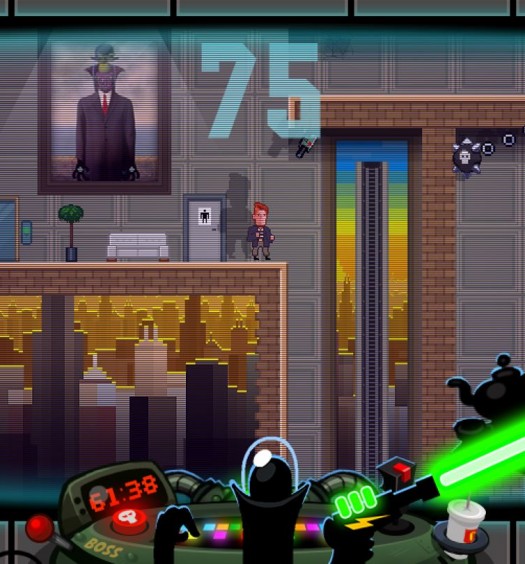A Pixel Story sees the protagonist take a journey to the core of The System as he tries to stop an evil OS from destroying everything in existence. The story travels through six different areas with various areas representing different points in gaming history. Each new generation ushers in a different visual treat and makes nods to games from that specific period which certainly made my nostalgia senses tingle. The game may be filled with references and nods to earlier generations and series, but that isn’t to say that there is nothing new on display.
Here’s what I liked:
The teleporting hat – Early on in the game I gained access to a hat that not only made my character look leagues more stylish but also added a host of new puzzles. The hat can be left anywhere with a simple press of the X button and the second press of X leads to the immediate teleportation of the game’s titular hero. The teleportation mechanic acts, in some scenarios, similar to how a double jump would be used but the hat offers much more than a double jump. Clever use of jump direction, jump height, character speed, and hat location produces a great variety of puzzles over the course of the game that all draw on the teleportation mechanic. The puzzles were resoundingly clever and varied over the course of the game in large part thanks to the teleportation mechanic.
References to the past – Games paying homage to the past is nothing new with Retro City Rampage and Evoland being two of the earlier pioneers. A Pixel Story focuses specifically on the platformers that have spanned the generations, and I found the references littered throughout the world to be clever and occasionally funny. Classic series like Mario and Sonic are of course referenced but so are countless others as well as numerous pop culture jokes. The “references” that stood out the most were the graphical styles from yesteryear all the way to present-day to be the most satisfyingly implemented. Every environment in A Pixel Story from the 8-bit worlds to the later current-generation graphical worlds is a joy to behold. The transition between four different art styles over the course of the game makes victory against the OS feel like a genuine triumph and journey.
Here’s what I didn’t like:
Pixel-perfect accuracy – There was not a puzzle that I encountered in A Pixel Story that I couldn’t think of a working solution for, however; the amount of puzzles I actually solved ended up being a small fraction of the total puzzles in the game. Successful execution of puzzle solutions was always a greater challenge than the act of actually discovering a proper solution. This is because most puzzles require seemingly pixel-perfect accuracy in order to be overcome. However, the controls and checkpoint system either greatly slowed me down or outright prevented me from finishing select puzzles throughout the game. Requiring pixel-perfect accuracy in a game is fine when the controls are tight, and the checkpoint system doesn’t prevent players from getting right back into the action, however; the controls are not tight, and I found the checkpoint system to be frustrating despite it only bringing me back to the beginning of the puzzle.
Something new or something old – I found A Pixel Story to be trapped between its two core ideas: servicing as a love letter to earlier platformers and acting as an innovation to the genre. The teleporting hat renders the gameplay radically different from most platformers that have come before especially earlier games in the genre. As I encountered more and more locales that were clearly derived from other games, I began to play in a state of perpetual confusion. I always had a sense of nostalgia being stirred by what I saw throughout the world, and yet it all felt completely foreign. Instead of power-ups and enemies scattered around the landscape, only puzzles can be seen. The world felt devoid of life, especially when compared to the games being referenced.
Wrap-up:
A Pixel Story is one of the more confounding games I have played in recent memory as its greatest strengths also end up being its greatest weaknesses. There are a lot of great ideas within A Pixel Story, but they fail to join and create a cohesive experience. The visual references and puzzles were often clever, but the actions required to solve puzzles diverged from what the references suggested should be taking place. A Pixel Story only borrows visual inspiration from the platformers that came before it and populates the rest of the world with their own ideas. My time with A Pixel Story left me wishing that far more from the past had made the leap to The System beyond visual representations.
Score: Reader’s Choice
A Pixel Story was developed by Lamplight Studios and published by Rising Star Games on Xbox One. It released on February 24, 2017 for $11.99. A copy was provided for review purposes.


